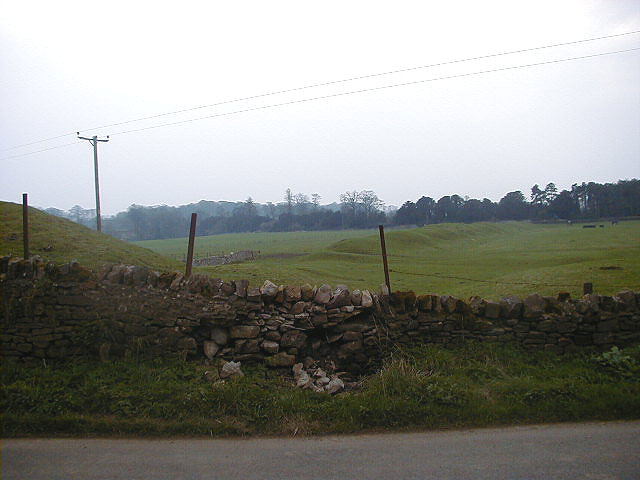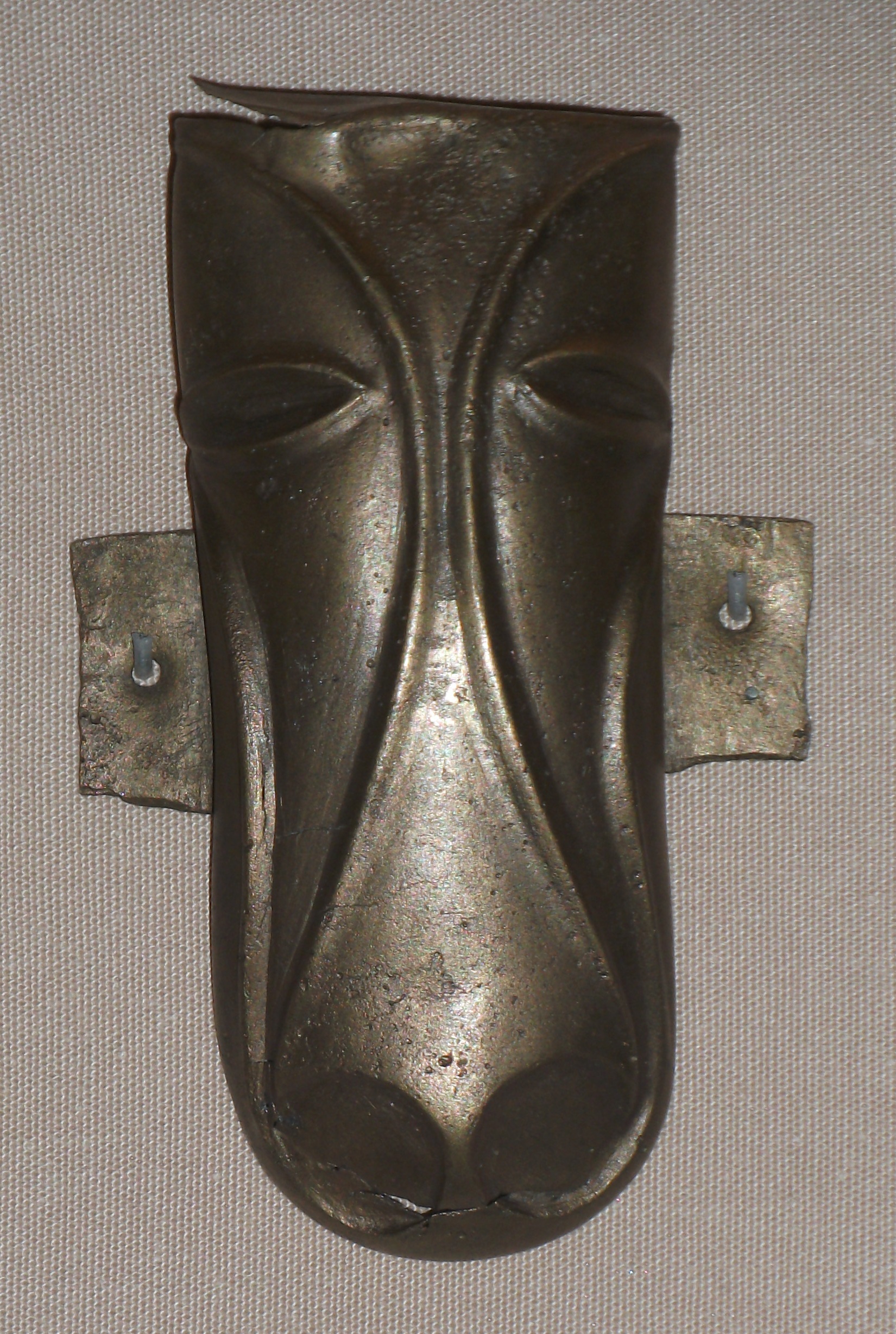Stanwick Iron Age Fortifications on:
[Wikipedia]
[Google]
[Amazon]

 The Stanwick Iron Age Fortifications (also known as 'Stanwick Camp'), a huge
The Stanwick Iron Age Fortifications (also known as 'Stanwick Camp'), a huge
Page on English Heritage's website
The Stanwick Fortifications
The Stanwick Horse Mask from the Stanwick hoard at the British Museum
Horse Harness from the Stanwick hoard at the British Museum
{{Iron Age hillforts in England English Heritage sites in North Yorkshire Hill forts in North Yorkshire History of North Yorkshire Iron Age sites in England

 The Stanwick Iron Age Fortifications (also known as 'Stanwick Camp'), a huge
The Stanwick Iron Age Fortifications (also known as 'Stanwick Camp'), a huge Iron Age
The Iron Age () is the final epoch of the three historical Metal Ages, after the Chalcolithic and Bronze Age. It has also been considered as the final age of the three-age division starting with prehistory (before recorded history) and progre ...
hill fort
A hillfort is a type of fortification, fortified refuge or defended settlement located to exploit a rise in elevation for defensive advantage. They are typical of the late Bronze Age Europe, European Bronze Age and Iron Age Europe, Iron Age. So ...
, sometimes but not always considered an oppidum
An ''oppidum'' (: ''oppida'') is a large fortified Iron Age Europe, Iron Age settlement or town. ''Oppida'' are primarily associated with the Celts, Celtic late La Tène culture, emerging during the 2nd and 1st centuries BC, spread acros ...
, comprising over of ditches and ramparts enclosing approximately of land, are situated in Richmondshire
{{Infobox settlement
, name = Richmondshire District
, type = Non-metropolitan district
, image_skyline =
, imagesize =
, image_caption =
, image_blank_emblem= Richmondshire arms.png
, blank_em ...
, North Yorkshire
North Yorkshire is a Ceremonial counties of England, ceremonial county in Northern England.The Unitary authorities of England, unitary authority areas of City of York, York and North Yorkshire (district), North Yorkshire are in Yorkshire and t ...
, England. Whether Stanwick was the stronghold of Venutius
Venutius was a 1st-century king of the Brigantes in northern Britain at the time of the Roman conquest. Some have suggested he may have belonged to the Carvetii, a tribe that probably formed part of the Brigantes confederation.
History firs ...
or Cartimandua
Cartimandua or Cartismandua (reigned ) was a 1st-century queen of the Brigantes, a Celtic people living in what is now northern England. She is known through the writings of Roman historian Tacitus.
She came to power during the time period that ...
, or perhaps of them both for a brief time before their acrimonious split some time after 51 AD, it is certain that this settlement was one of the most important in Brigantia, the Brigantes
The Brigantes were Ancient Britons who in pre-Roman times controlled the largest section of what would become Northern England. Their territory, often referred to as Brigantia, was centred in what was later known as Yorkshire. The Greek geog ...
kingdom during the early stages of the Roman occupation of Britain. The site is a scheduled monument.
Location and etymology
The fortifications are located north of the town ofRichmond
Richmond most often refers to:
* Richmond, British Columbia, a city in Canada
* Richmond, California, a city in the United States
* Richmond, London, a town in the London Borough of Richmond upon Thames, England
* Richmond, North Yorkshire, a town ...
and south west of Darlington
Darlington is a market town in the Borough of Darlington, County Durham, England. It lies on the River Skerne, west of Middlesbrough and south of Durham. Darlington had a population of 107,800 at the 2021 Census, making it a "large town" ...
, close to Scotch Corner and the remains of the Roman fort and bridge at Piercebridge. Rising to a height of almost in places, the ramparts completely surround the village of Stanwick St John and form one of the largest Iron Age settlements in Britain, in extent if not necessarily in population. The name 'Stanwick' is thought to be derived from the Old Norse
Old Norse, also referred to as Old Nordic or Old Scandinavian, was a stage of development of North Germanic languages, North Germanic dialects before their final divergence into separate Nordic languages. Old Norse was spoken by inhabitants ...
word 'steinvegges', meaning stone walls; although an Anglo-Saxon
The Anglo-Saxons, in some contexts simply called Saxons or the English, were a Cultural identity, cultural group who spoke Old English and inhabited much of what is now England and south-eastern Scotland in the Early Middle Ages. They traced t ...
etymology
Etymology ( ) is the study of the origin and evolution of words—including their constituent units of sound and meaning—across time. In the 21st century a subfield within linguistics, etymology has become a more rigorously scientific study. ...
, from ''stān'' "stone" and ''wic'' "settlement", is also plausible.
Stanwick Hoard
In 1845 a hoard of 140 metal artefacts known as the ''Stanwick Hoard'', which included four sets of horse harness for chariots and a bronze horse head 'bucket attachment', was found away at Melsonby. The hoard is now held by theBritish Museum
The British Museum is a Museum, public museum dedicated to human history, art and culture located in the Bloomsbury area of London. Its permanent collection of eight million works is the largest in the world. It documents the story of human cu ...
, which also has the Meyrick Helmet, which may have been part of the hoard or have been made at Stanwick.
Mortimer Wheeler excavations
Stanwick was the site of SirMortimer Wheeler
Sir Robert Eric Mortimer Wheeler Member of the Order of the Companions of Honour, CH Companion of the Order of the Indian Empire, CIE Military Cross, MC Territorial Decoration, TD (10 September 1890 – 22 July 1976) was a British archaeolo ...
's last major archaeological excavation in Britain, which he carried out over the summers of 1951 and 1952. Wheeler argued that the vast site had been constructed in three separate 'phases' starting from a modest earthwork enclosure on a low hill known as 'The Tofts', dated to around 40 AD (Phase I) then extended around 50–60 AD with a new enclosure to the north of over (Phase II), and then finally, around 72 AD, extended by a further to the south (Phase III).
During the course of his excavations, Wheeler cleared a section of ditch that the Brigantes
The Brigantes were Ancient Britons who in pre-Roman times controlled the largest section of what would become Northern England. Their territory, often referred to as Brigantia, was centred in what was later known as Yorkshire. The Greek geog ...
had cut from the underlying limestone rock. He partially reconstructed a length of dry-stone revetment wall from the fallen stones found in the ditch. This was constructed to an approximate height of above the existing rampart, although Wheeler estimated that the original height of the wall above the rampart was probably closer to . Known as 'Wheeler's Wall', this entire section remains preserved by English Heritage
English Heritage (officially the English Heritage Trust) is a charity that manages over 400 historic monuments, buildings and places. These include prehistoric sites, a battlefield, medieval castles, Roman forts, historic industrial sites, Lis ...
and provides the visitor to Stanwick with a clear impression of how awe-inspiring the fortifications would have been in Iron Age times.
Amongst Wheeler's most famous finds at Stanwick were an Iron Age sword, unusually still in its well-preserved ash wood scabbard, and the nearby skull of a severed head, showing considerable damage from wounds inflicted by an axe or a sword. These were found in an excavation of a ditch terminal next to the location of the main north western gate and Wheeler believed they may have been hanging from the gate structure itself as a trophy or warning to enemies. Wheeler concluded that Stanwick had been the rebel stronghold of Venutius
Venutius was a 1st-century king of the Brigantes in northern Britain at the time of the Roman conquest. Some have suggested he may have belonged to the Carvetii, a tribe that probably formed part of the Brigantes confederation.
History firs ...
, who had been the husband of the pro-Roman Brigantian queen Cartimandua
Cartimandua or Cartismandua (reigned ) was a 1st-century queen of the Brigantes, a Celtic people living in what is now northern England. She is known through the writings of Roman historian Tacitus.
She came to power during the time period that ...
, after he had split with her when she had taken his charioteer and armour-bearer Vellocatus
Vellocatus was a first-century king of the Brigantes tribe of northern Roman Britain, Britain.
He was originally armour-bearer to Venutius, husband of Cartimandua, the queen of the Brigantes and an ally of Roman Empire, Rome. Some time after 51 ...
as a lover and betrayed the rebel leader Caractacus to the Romans. Wheeler argued that Stanwick was where Venutius
Venutius was a 1st-century king of the Brigantes in northern Britain at the time of the Roman conquest. Some have suggested he may have belonged to the Carvetii, a tribe that probably formed part of the Brigantes confederation.
History firs ...
had rallied his anti-Roman tribesmen and allies for his revolt against the Roman invaders.
Durham University excavations
The next series of major archaeological excavations at Stanwick were carried out from 1981 to 1986 by a team fromDurham University
Durham University (legally the University of Durham) is a collegiate university, collegiate public university, public research university in Durham, England, founded by an Act of Parliament (UK), Act of Parliament in 1832 and incorporated by r ...
led by Percival Turnbull and Professor Colin Haselgrove. One of their most enigmatic finds was an adult male burial at the rear of a rampart in the fortifications where a horse's head had been carefully placed upon the body.Haselgrove, C. and Turnbull, P. with Fitts, M. and Van der Veen, M.: "Stanwick: Excavation and Research – Third Interim Report 1985-86", page 10, University of Durham, Department of Archaeology, Occasional Paper No.8, 1987 and Haselgrove, C: 'Stanwick' in "Current Archaeology" No. 119 (pp. 380–384), page 384 Turnbull and Haselgrove argued that Stanwick's huge outer circuit of ditches and banks had probably been built first, during the mid-first century AD, and then the inner area sub-divided. They maintained that the fortification was too long to be easily defended and that its enormous size was intended instead to emphasise the power, prestige and wealth of its owner. They concluded that Stanwick had not been the fortress stronghold of Venutius
Venutius was a 1st-century king of the Brigantes in northern Britain at the time of the Roman conquest. Some have suggested he may have belonged to the Carvetii, a tribe that probably formed part of the Brigantes confederation.
History firs ...
but was rather the estate of his ex-wife, Queen Cartimandua
Cartimandua or Cartismandua (reigned ) was a 1st-century queen of the Brigantes, a Celtic people living in what is now northern England. She is known through the writings of Roman historian Tacitus.
She came to power during the time period that ...
, and possibly even the original tribal capital of the Brigantes
The Brigantes were Ancient Britons who in pre-Roman times controlled the largest section of what would become Northern England. Their territory, often referred to as Brigantia, was centred in what was later known as Yorkshire. The Greek geog ...
.
See also
* List of hill forts in England * List of hill forts in Scotland * List of hill forts in Wales * Melsonby HoardReferences
External links
*Page on English Heritage's website
The Stanwick Fortifications
The Stanwick Horse Mask from the Stanwick hoard at the British Museum
Horse Harness from the Stanwick hoard at the British Museum
{{Iron Age hillforts in England English Heritage sites in North Yorkshire Hill forts in North Yorkshire History of North Yorkshire Iron Age sites in England